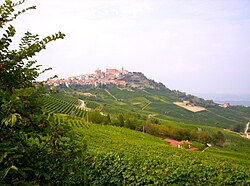La Morra | |
|---|---|
| Comune di La Morra | |
 | |
| Coordinates: 44°38′N7°56′E / 44.633°N 7.933°E | |
| Country | Italy |
| Region | Piedmont |
| Province | Cuneo (CN) |
| Frazioni | Annunziata, Santa Maria, Rivalta, Berri |
| Government | |
| • Mayor | Marialuisa Ascheri |
| Area | |
• Total | 24.3 km2 (9.4 sq mi) |
| Elevation | 513 m (1,683 ft) |
| Population (31 December 2010) [2] | |
• Total | 2,758 |
| • Density | 110/km2 (290/sq mi) |
| Demonym | Lamorresi |
| Time zone | UTC+1 (CET) |
| • Summer (DST) | UTC+2 (CEST) |
| Postal code | 12064 |
| Dialing code | 0173 |
| Website | Official website |
La Morra is a comune (municipality) in the Province of Cuneo in the Italian region Piedmont, located about 50 kilometres (31 mi) southeast of Turin and about 40 kilometres (25 mi) northeast of Cuneo. As of 31 December 2004, it had a population of 2,668 and an area of 24.3 square kilometres (9.4 sq mi). [3]
Contents
The municipality of La Morra contains the frazioni (subdivisions, mainly villages and hamlets) Annunziata, Santa Maria, Rivalta, and Berri.
La Morra borders the following municipalities: Alba, Barolo, Bra, Castiglione Falletto, Cherasco, Narzole, Roddi, and Verduno.




